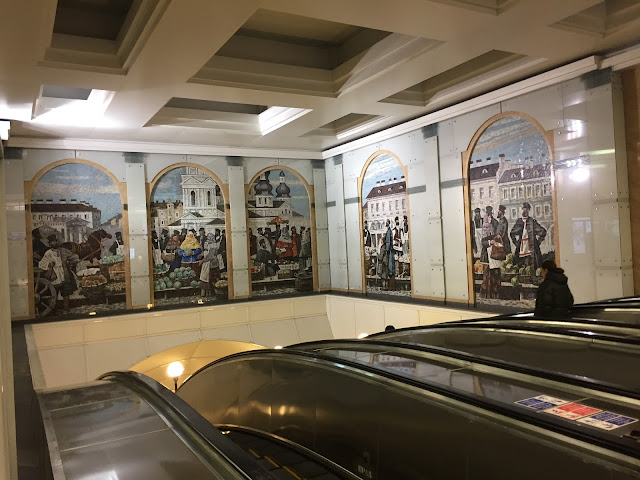189. Sennaya Ploshchad & Spasskaya Metro Station
The Spasskaya Metro station is one of three interconnected stations that lie underneath Sennaya Ploshchad - St. Petersburg's "Hay Square" (the other two stations are known as Sadovaya and Sennaya Ploshchad). Sennaya Ploshchad is located south of Nevsky Prospekt, between the Fontanka River to the east and the Griboyedov Canal to the west. This is where the blue, orange, and purple Metro lines intersect, so the area is one of the busier transportation hubs in the city center. I passed through the Spasskaya and Sennaya Ploshchad stations almost every day while I lived in the city, as the transfer here from the orange to the blue lines was one of the more convenient routes for my daily commute.
For more than three centuries, Sennaya Ploshchad has been associated primarily with the large market in the square, as well as the surrounding neighborhood - which was one of the poorest parts of the city during the eighteenth and nineteenth centuries. A pair of nineteenth-century writers have immortalized the square, the surrounding slums and taverns, and the inhabitants of the area in their works: Fyodor Dostoyevsky (most notably in Crime and Punishment and The Idiot) and Vesevolod Krestovsky (in "The Slums of St. Petersburg", which does not appear to have been translated into English). Although there is no longer a market in the square, vendors still ply their wares throughout the area; some of the commercial streets nearby are still quite seedy.
The Spasskaya station opened in March 2009. Although I only used the entrance lobby on nights or weekends when I was going to places in this part of the city, I always enjoyed seeing the mosaic panels here. They cover 45 square meters (485 square feet) and depict the market in Sennaya Ploshchad in the nineteenth century, featuring characters from the works of Pushkin, Gogol, and Dostoyevsky. The Assumption Church also appears in the panels, but this building no longer exists. It was the most prominent landmark in the neighborhood for two centuries; it was first built in 1753, and unfortunately demolished in 1961 during a period of particular anti-religious sentiment in the Soviet era. The mosaic panels were created by artists from the Russian Academy of Art and use approximately two tons of enamel tiles.
For more than three centuries, Sennaya Ploshchad has been associated primarily with the large market in the square, as well as the surrounding neighborhood - which was one of the poorest parts of the city during the eighteenth and nineteenth centuries. A pair of nineteenth-century writers have immortalized the square, the surrounding slums and taverns, and the inhabitants of the area in their works: Fyodor Dostoyevsky (most notably in Crime and Punishment and The Idiot) and Vesevolod Krestovsky (in "The Slums of St. Petersburg", which does not appear to have been translated into English). Although there is no longer a market in the square, vendors still ply their wares throughout the area; some of the commercial streets nearby are still quite seedy.
The Spasskaya station opened in March 2009. Although I only used the entrance lobby on nights or weekends when I was going to places in this part of the city, I always enjoyed seeing the mosaic panels here. They cover 45 square meters (485 square feet) and depict the market in Sennaya Ploshchad in the nineteenth century, featuring characters from the works of Pushkin, Gogol, and Dostoyevsky. The Assumption Church also appears in the panels, but this building no longer exists. It was the most prominent landmark in the neighborhood for two centuries; it was first built in 1753, and unfortunately demolished in 1961 during a period of particular anti-religious sentiment in the Soviet era. The mosaic panels were created by artists from the Russian Academy of Art and use approximately two tons of enamel tiles.












Comments
Post a Comment